SpringCloud 学习笔记总结
Posted IT_Holmes
tags:
篇首语:本文由小常识网(cha138.com)小编为大家整理,主要介绍了SpringCloud 学习笔记总结相关的知识,希望对你有一定的参考价值。
文章目录
- 1. zookeeper 之 支付服务注册(服务提供者注册)
- 2. zookeeper 之 临时节点和持久节点
- 3. zookeeper 之 服务消费者注册
- 4. Consul 之 简介
- 5. Consul 之 安装运行Consul
- 6. Consul 之 服务提供者注册进consul
- 7. Consul 之 服务消费者注册进Consul
- 8. 三个注册中心的异同点
- 9. Ribbon 之 介绍
- 10. Ribbon 之 负载均衡和Rest调用
- 11. Ribbon 之 默认自带的负载均衡策略
- 12. Ribbon 之 负载均衡规则替换
- 13. Ribbon 默认负载均衡轮询算法原理
- 14. 手写 Ribbon 的轮询算法
1. zookeeper 之 支付服务注册(服务提供者注册)

zookeeper官方下载:
第一步:创建一个新的业务逻辑项目方便测试,导入对应的zookeeper依赖:
<!--SpringBoot整合zookeeper客户端-->
<dependency>
<groupId>org.springframework.cloud</groupId>
<artifactId>spring-cloud-starter-zookeeper-discovery</artifactId>
</dependency>
第二步:配置application.yml:
server:
port: 8004
# 服务别名--注册zookeeper到注册中心名称
spring:
application:
name: cloud-provider-payment
cloud:
# 注册到zookeeper
zookeeper:
connect-string: 150.158.199.52:2181
第三步:添加SpringBoot 启动类:
package com.itholmes.springcloud;
import org.springframework.boot.SpringApplication;
import org.springframework.boot.autoconfigure.SpringBootApplication;
import org.springframework.cloud.client.discovery.EnableDiscoveryClient;
@SpringBootApplication
/**
* 注解@EnableDiscoveryClient:
* 用于像使用consul或者zookeeper作为注册中心时注册服务。
*/
@EnableDiscoveryClient
public class PaymentMain8004
public static void main(String[] args)
SpringApplication.run(PaymentMain8004.class,args);
第四步:进入zookeeper的bin目录下,通过./zkServer.sh start 启动zookeeper:
- ./zkServer.sh start 启动zookeeper。
- ./zkCli.sh 进入zookeeper客户端。
- 启动之前
一定要看看conf目录下面的zoo.cfg文件,一般会有一个zoo.sample.cfg,需要将其复制出一份zoo.cfg文件才能正常启动zookeeper。
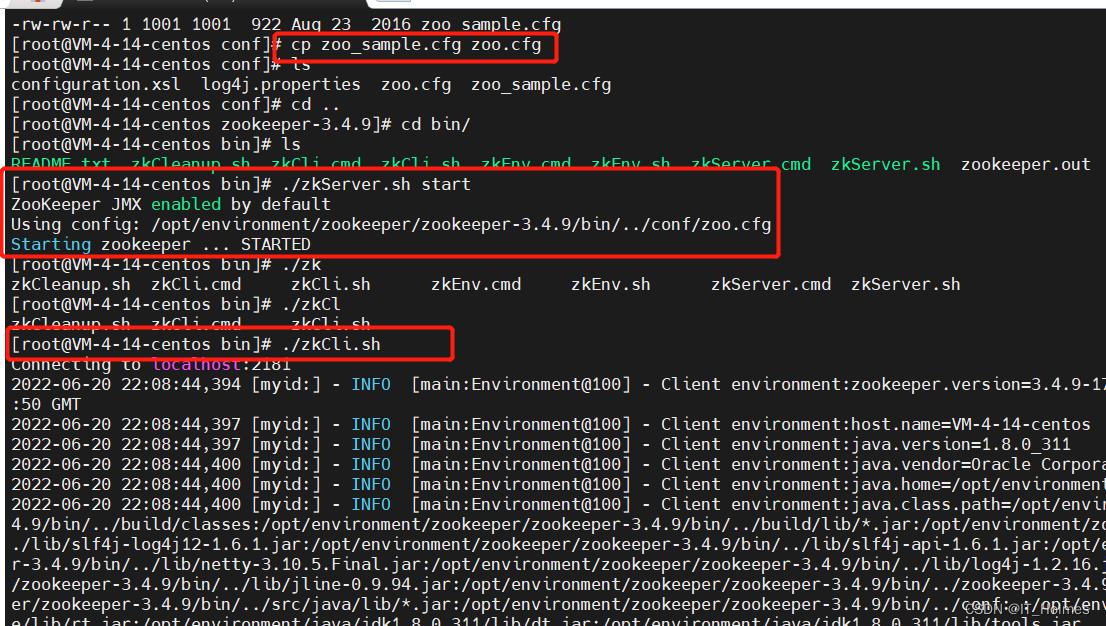
注意:
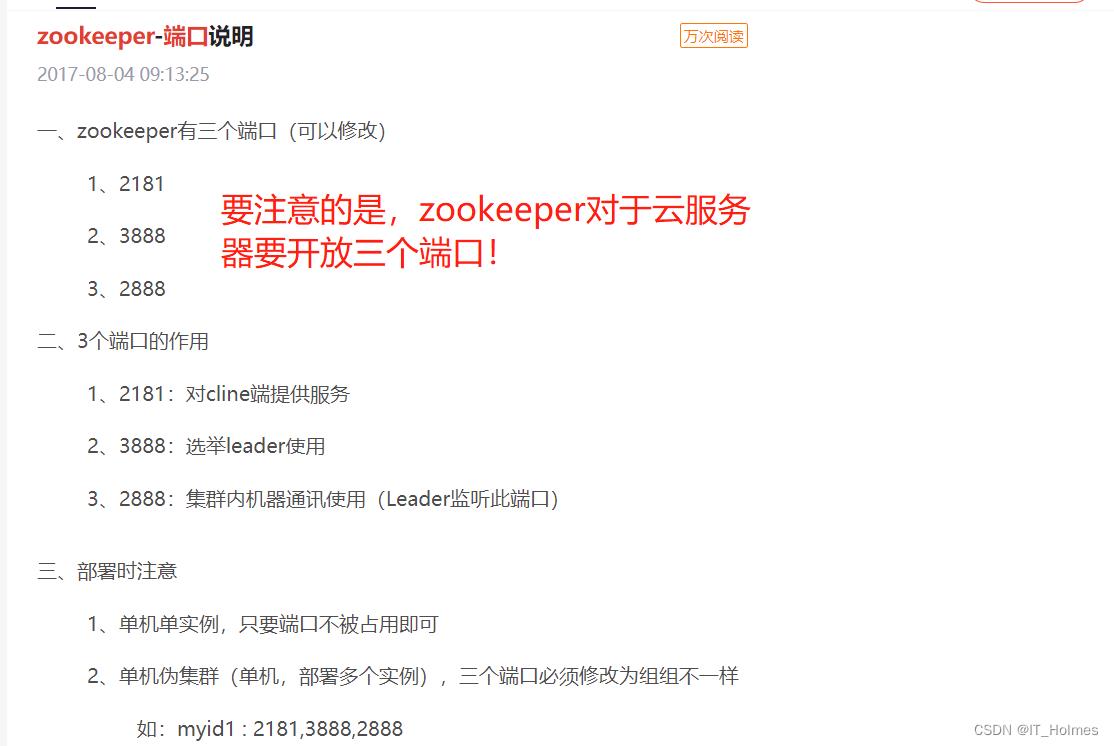
第五步:启动业务逻辑项目。
-
可能遇到jar冲突!zookeeper的依赖jar包与服务器安装的zookeeper版本不一致就会出现jar包冲突的问题!
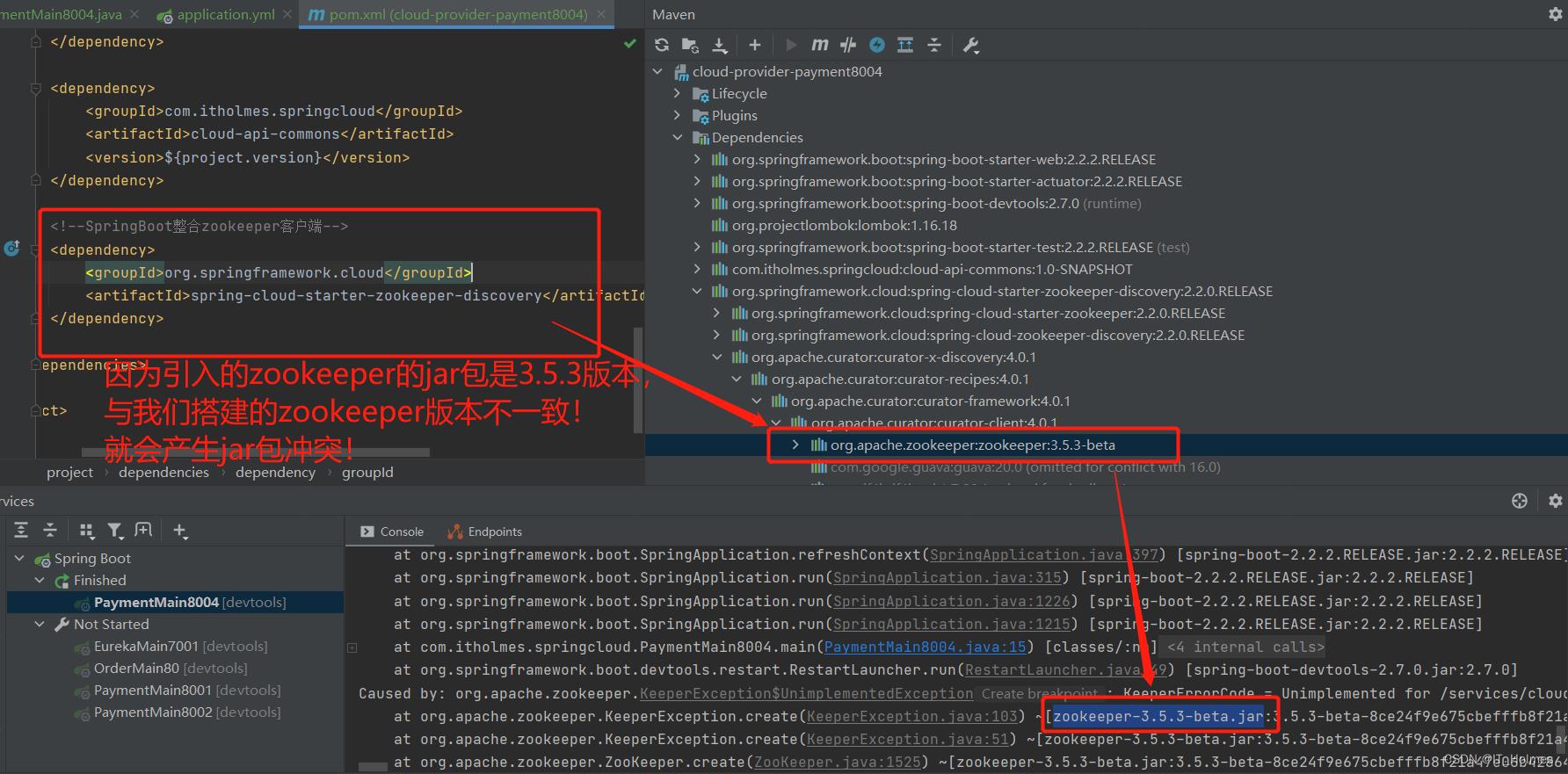
怎样解决zookeeper版本jar包与服务器的版本冲突的问题? -
可以通过exclusions排除jar包自带的zookeeper3.5.3版本呢,添加其他版本的依赖。
<!--SpringBoot整合zookeeper客户端-->
<dependency>
<groupId>org.springframework.cloud</groupId>
<artifactId>spring-cloud-starter-zookeeper-discovery</artifactId>
<exclusions>
<!--排除自身版本的zookeeper-->
<exclusion>
<groupId>org.apache.zookeeper</groupId>
<artifactId>zookeeper</artifactId>
</exclusion>
</exclusions>
</dependency>
<!--添加新版本的zookeeper。-->
<dependency>
<groupId>org.apache.zookeeper</groupId>
<artifactId>zookeeper</artifactId>
<version>3.4.9</version>
</dependency>
第六步:启动项目,查看zookeeper服务是否注册进去了。


2. zookeeper 之 临时节点和持久节点
zookeeper可以分为临时节点和持久节点。
还可以细分为无序号的临时节点,带序号的临时节点,无序号的持久节点,带序号的持久节点。
当前服务器上zookeeper,当我们关闭业务逻辑系统时,zookeeper一定时间内接收不到心跳就会立刻将服务注册的信息删除掉,表明这台zookeeper服务器是临时节点。
3. zookeeper 之 服务消费者注册
将消费者系统注册到zookeeper中,并且从zookeeper中拿到提供者的信息。
第一步:同样项目创建服务消费者,配置pom,创建springboot启动类。
package com.itholmes.springcloud;
import org.springframework.boot.SpringApplication;
import org.springframework.boot.autoconfigure.SpringBootApplication;
import org.springframework.cloud.client.discovery.EnableDiscoveryClient;
@SpringBootApplication
// 不要忘记添加!!!
@EnableDiscoveryClient
public class OrderZKMain
public static void main(String[] args)
SpringApplication.run(OrderZKMain.class,args);
第二步:将服务消费者,注册到zookeeper当中。
server:
port: 80
# 服务别名--注册zookeeper到注册中心名称
spring:
application:
name: cloud-consumer-order
cloud:
# 注册到zookeeper
zookeeper:
connect-string: 150.158.199.52:2181
第三步:添加RestTemplate对象到容器中,同时不要忘记添加@LoadBalanced注解:
package com.itholmes.springcloud.config;
import org.springframework.cloud.client.loadbalancer.LoadBalanced;
import org.springframework.context.annotation.Bean;
import org.springframework.context.annotation.Configuration;
import org.springframework.web.client.RestTemplate;
@Configuration
public class ApplicationContextConfig
@Bean
//添加@LoadBalanced负载均衡注解
@LoadBalanced
public RestTemplate getRestTemplate()
return new RestTemplate();
第四步:添加一个controller层,通过服务注册的微服务名称,使用RestTemplate来进行访问即可:
package com.itholmes.springcloud.controller;
import lombok.extern.slf4j.Slf4j;
import org.springframework.web.bind.annotation.GetMapping;
import org.springframework.web.bind.annotation.RestController;
import org.springframework.web.client.RestTemplate;
import javax.annotation.Resource;
@RestController
@Slf4j
public class OrderZKController
public static final String INVOKE_URL = "http://cloud-provider-payment";
@Resource
private RestTemplate restTemplate;
@GetMapping("/consumer/payment/zk")
public String paymentInfo()
String result = restTemplate.getForObject(INVOKE_URL + "/payment/zk", String.class);
return result;
在这我依然还是遇到了域名不能包含下划线的问题!
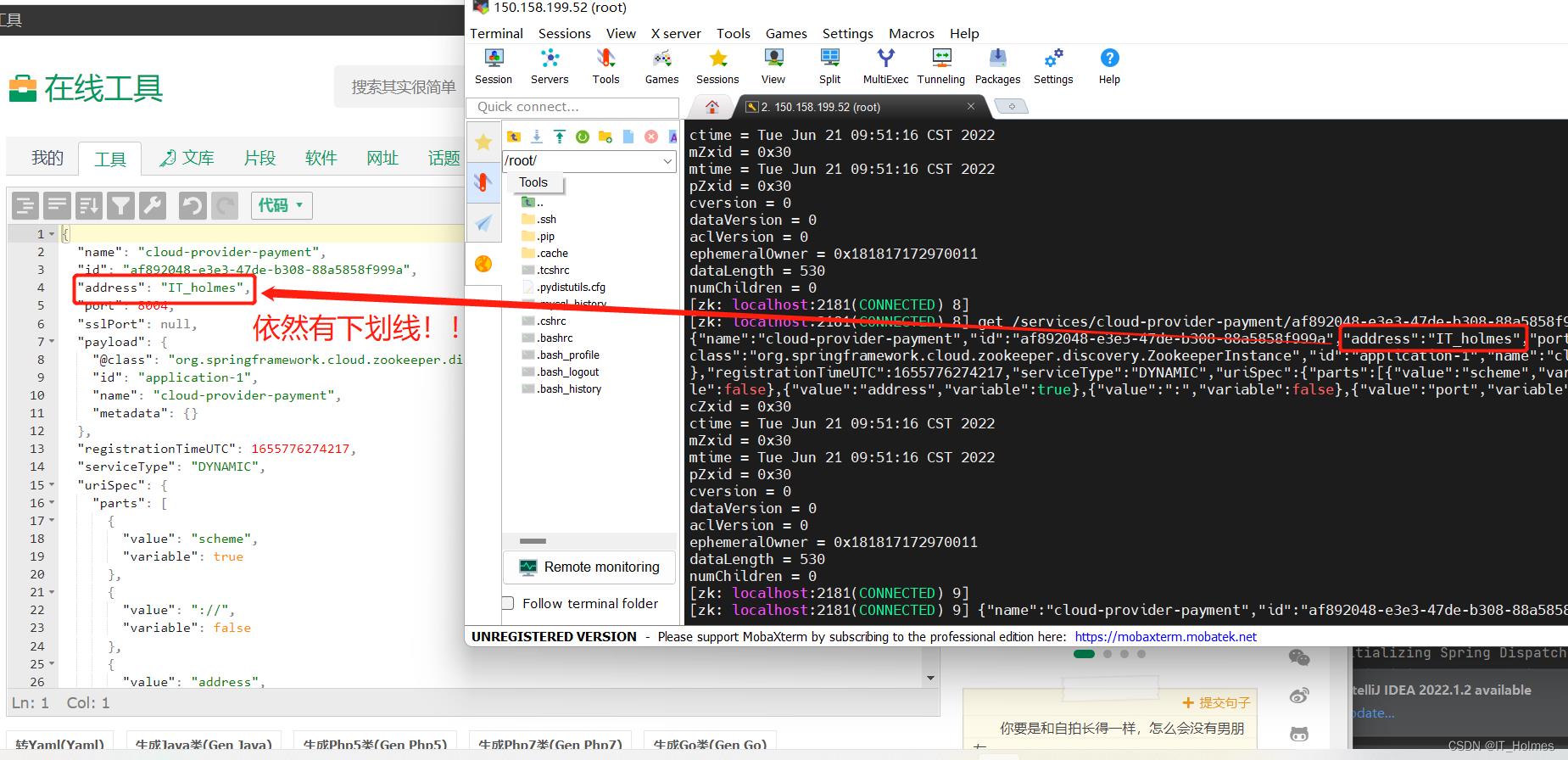
所以最后还是被折服了,决定修改计算机主机名字。。。

4. Consul 之 简介
Consul是一套开源的分布式服务发现和配置管理系统,由HahsiCorp公司用go语言开发的。
Consul的优势:
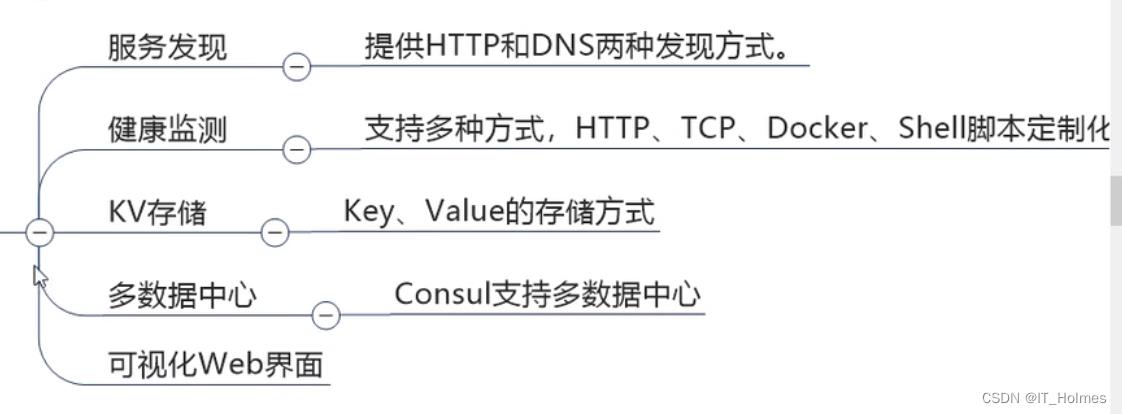
下载地址:https://learn.hashicorp.com/tutorials/consul/get-started-install
5. Consul 之 安装运行Consul
去官方下载Consul的压缩包,传到服务器中:
- 对于zip文件,使用unzip命令来解压。
使用consul --version来查看consul版本:

通过consul agent -dev 通过开发模式启动consul:
- 注意:如果是云端访问,还需要加-client 0.0.0.0参数。
consul agent -dev # 该命令启动只能允许本机访问
consul agent -dev -client 0.0.0.0 # 加上-client 0.0.0.0就可以其他机器进行访问了
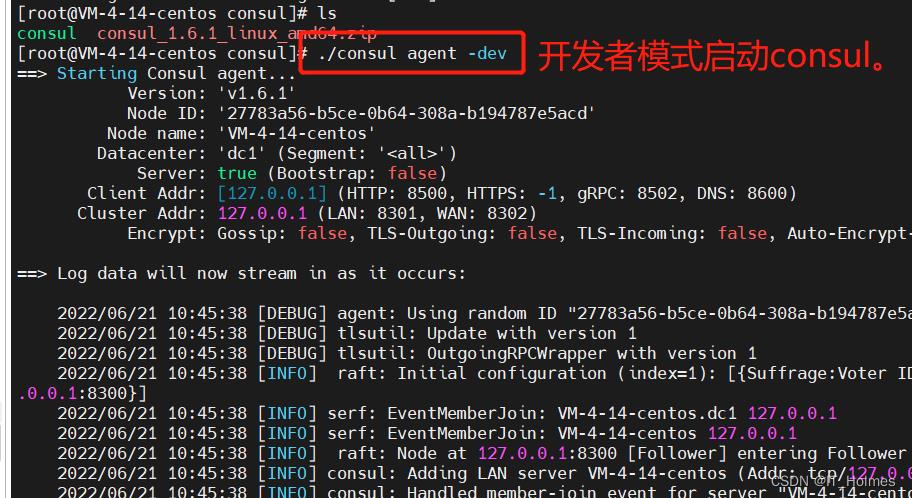
这样我们访问页面就可以进入consul的web页面:
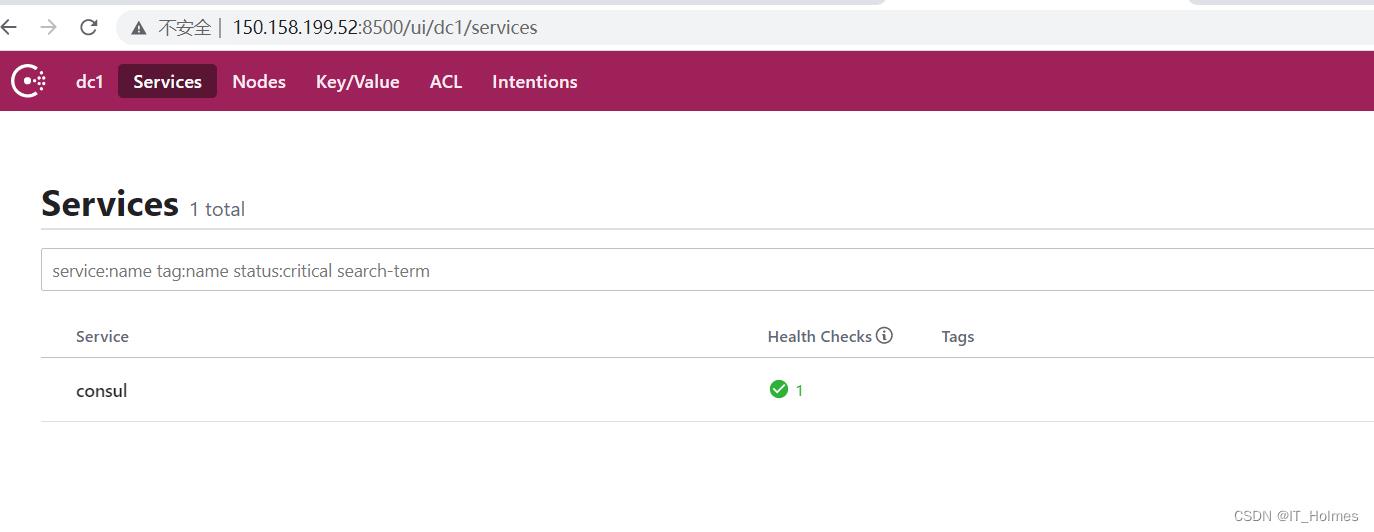
6. Consul 之 服务提供者注册进consul
同样创建服务提供者项目,改pom导依赖,添加配置文件和启动类。
第一步:对应consul的重要依赖:
<!--SpringCloud consul-server的客户端-->
<dependency>
<groupId>org.springframework.cloud</groupId>
<artifactId>spring-cloud-starter-consul-discovery</artifactId>
</dependency>
<dependency>
<groupId>org.springframework.boot</groupId>
<artifactId>spring-boot-starter-web</artifactId>
</dependency>
<dependency>
<groupId>org.springframework.boot</groupId>
<artifactId>spring-boot-starter-actuator</artifactId>
</dependency>
第二步:SpringBoot对consul,application.yml的整合。
server:
port: 8006
spring:
application:
# 微服务名称
name: consul-provider-payment
# consul注册中心地址
cloud:
consul:
host: 150.158.199.52
port: 8500
discovery:
# hostname: 127.0.0.1
service-name: $spring.application.name
# healthbeat.enable 为 true 就是打开心跳机制,重新启动服务就不会再出现前面的问题了。
heartbeat:
enabled: true
第三步:添加主启动类。
package com.itholmes.springcloud;
import org.springframework.boot.SpringApplication;
import org.springframework.boot.autoconfigure.SpringBootApplication;
import org.springframework.cloud.client.discovery.EnableDiscoveryClient;
@SpringBootApplication
@EnableDiscoveryClient
public class PaymentMain8006
public static void main(String[] args)
SpringApplication.run(PaymentMain8006.class,args);
第四步:就可以在consul web页面查看到。
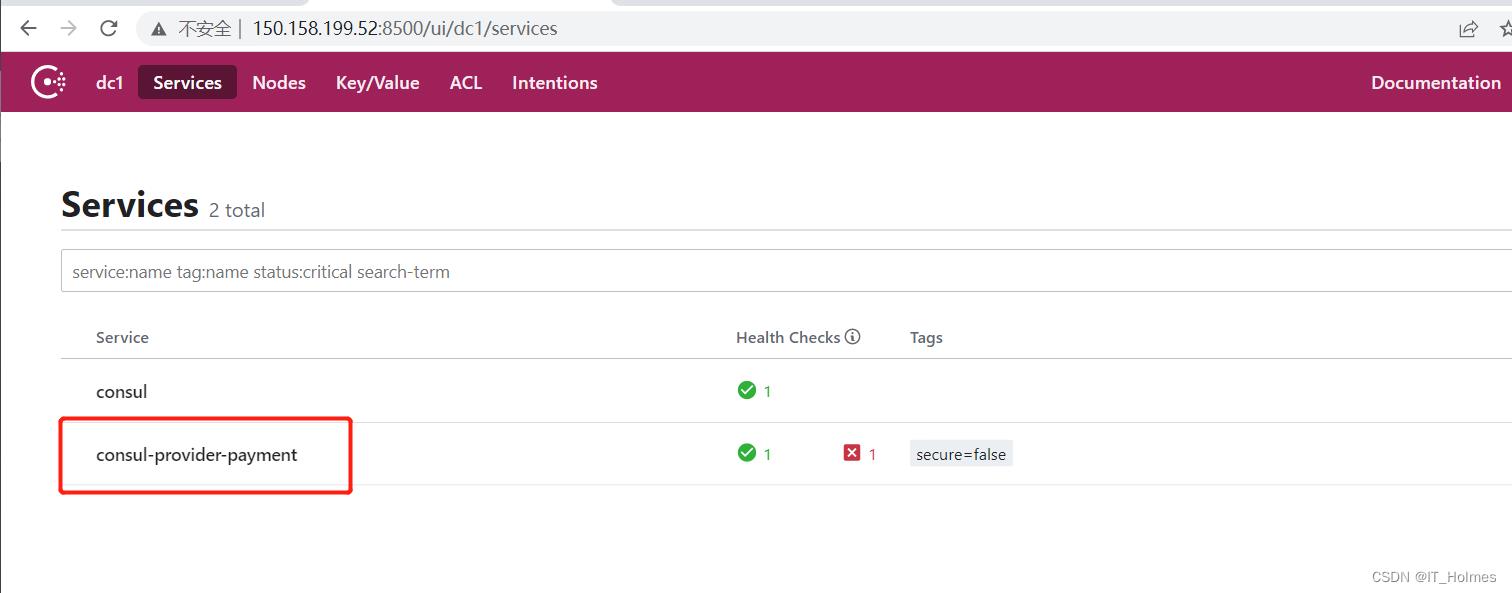
(注意如果没有开启心跳检测就会出现上面的红叉。)
7. Consul 之 服务消费者注册进Consul
同样创建服务提供者项目,改pom导依赖,添加配置文件和启动类。
application.yml配置:
server:
port: 80
spring:
application:
# 微服务名称
name: consul-consumer-order
# consul注册中心地址
cloud:
consul:
host: 150.158.199.52
port: 8500
discovery:
# hostname: 127.0.0.1
service-name: $spring.application.name
# healthbeat.enable 为 true 就是打开心跳机制,重新启动服务就不会再出现前面的问题了。
heartbeat:
enabled: true
配置类RestTemplate不要忘记添加@LoadBalanced注解:
package com.itholmes.springcloud.config;
import org.springframework.cloud.client.loadbalancer.LoadBalanced;
import org.springframework.context.annotation.Bean;
import org.springframework.context.annotation.Configuration;
import org.springframework.web.client.RestTemplate;
@Configuration
public class ApplicationContextConfig
@Bean
//添加@LoadBalanced负载均衡注解
@LoadBalanced
public RestTemplate getRestTemplate()
return new RestTemplate();
启动配置类:
package com.itholmes.springcloud;
import org.springframework.boot.SpringApplication;
import org.springframework.boot.autoconfigure.SpringBootApplication;
import org.springframework.cloud.client.discovery.EnableDiscoveryClient;
@SpringBootApplication
@EnableDiscoveryClient//该注解用于向使用consul或者zookeeper作为注册中心注册服务
public class OrderConsulMain80
public static void main(String[] args)
SpringApplication.run(OrderConsulMain80.class,args);
8. 三个注册中心的异同点
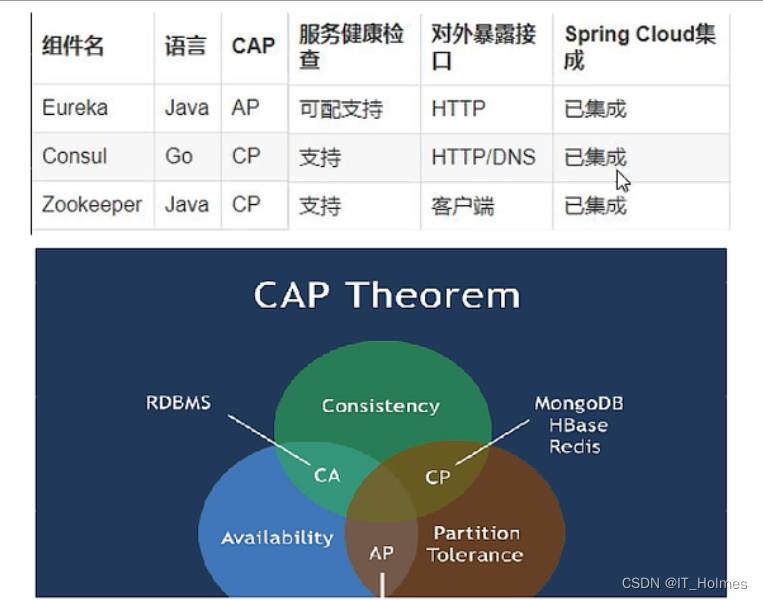
CAP理念:

由于是分布式微服务,所以P是要永远保证的,要么是CP,要么是AP。
- eureka分支是AP。
- zoo keeper和consul分支是CP。
9. Ribbon 之 介绍
SpringCloud Ribbon 是基于Netflix Ribbon实现的一套客户端 负载均衡的工具。
Ribbon的作用:主要功能是提供客户端的软件负载均衡算法和服务调用。
Ribbon客户端组件提供一系列完善项如连接超时,重试等。简单说,就是在配置文件中列出Load Balancer(简称LB,负载均衡)后面所有的机器,Ribbon会自动的帮助你基于某种规则(如简单轮询,随机连接等) 去连接这些机器。
Ribbon的github地址:https://github.com/Netflix/ribbon
ribbon目前已经维护,但是仍然有很多项目中使用!
常见的负载均衡的软件有:Nginx,LVS,硬件F5等。
LB负载均衡有两种:集中式LB 和 进程内LB。
- Nginx是服务器负载均衡,属于集中式LB。
- Ribbon是本地负载均衡,属于进程式LB。

所以说Ribbon本质上就是RestTemplate + 负载均衡调用。
10. Ribbon 之 负载均衡和Rest调用
10.1 Ribbon 环境引入
Ribbon就是一个软负载均衡的客户端组件。
下图就是一个Ribbon与Eureka Server结合的架构图:
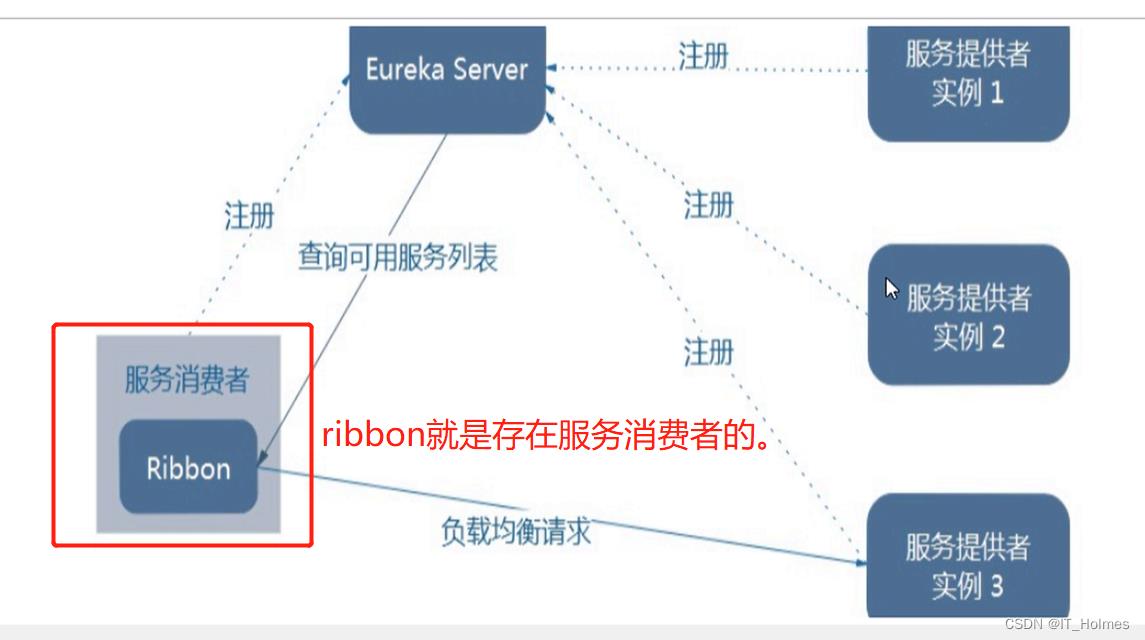
Ribbon有多种策略:比如轮询,随机和根据相应时间加权。
正常情况下,我们需要引入:
<dependency>
<groupId>org.springframework.cloud</groupId>
<artifactId>spring-cloud-starter-ribbon</artifactId>
</dependency>
但是新版的spring-cloud-starter-netflix-eureka-client里面已经整合了ribbon!因此我们使用eureka的时候就有了负载均衡的效果。
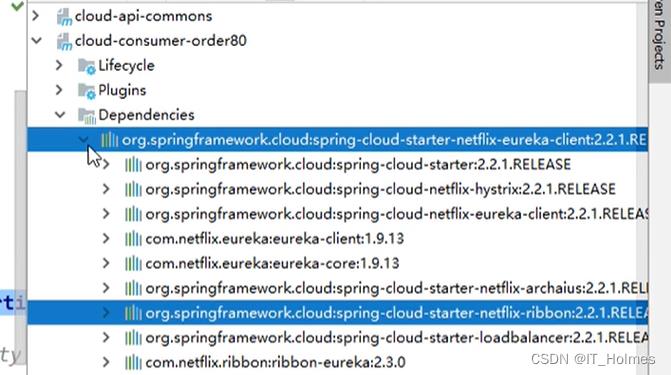
10.2 RestTemplate 使用
RestTemplate主要有两种object和entity:
- object返回对象为响应体中数据转化的对象,就是json样子。
- entity返回对象为ResponseEntity对象,包含了一些响应的重要信息,响应头,响应状态码,响应体等等。(最近写过的一个项目,就恰好用到了配置响应头传递token)。
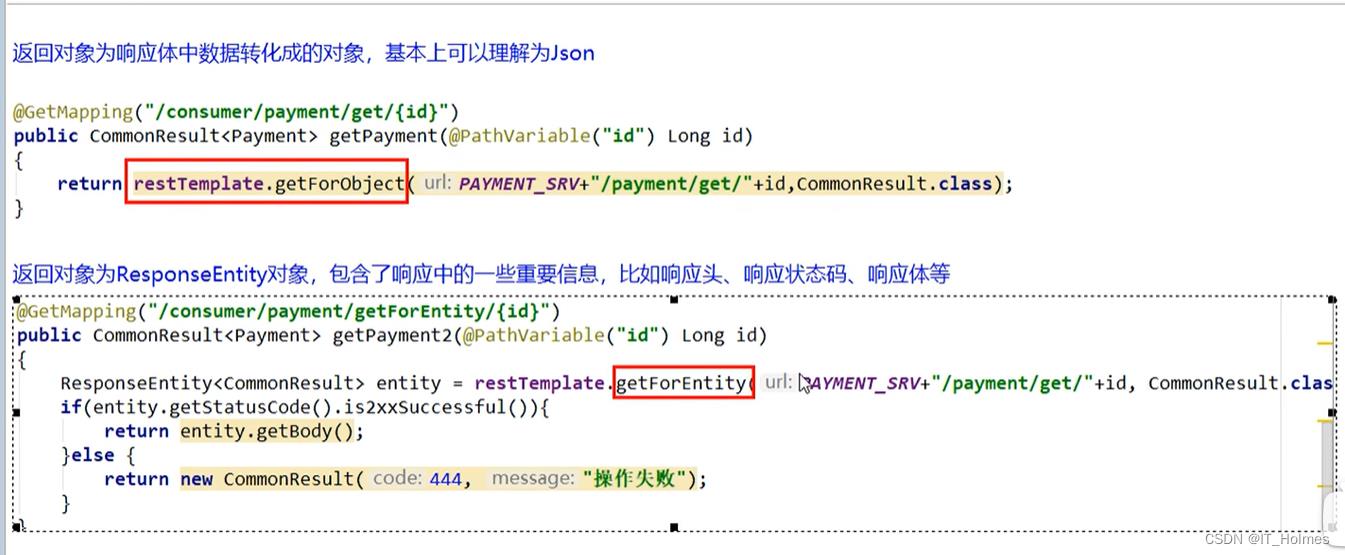
11. Ribbon 之 默认自带的负载均衡策略
ribbon自带的几个默认负载均衡策略:

Ribbon的核心组件iRule接口:
- 上面几个默认的都是实现iRule接口的实现类中实现的。
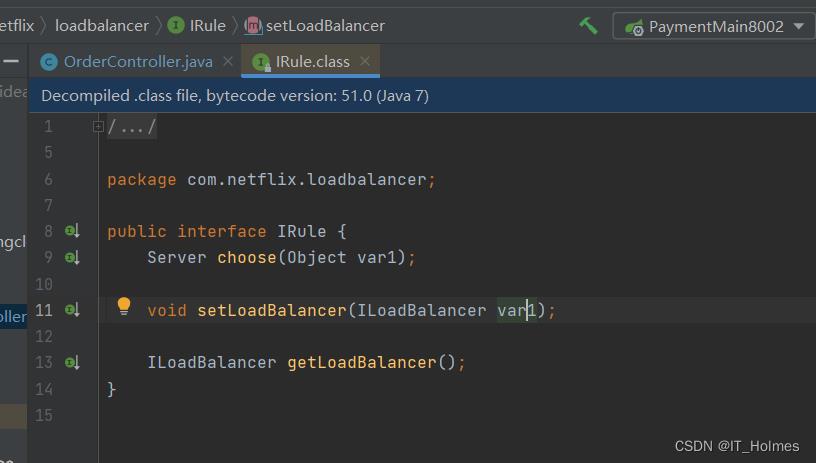

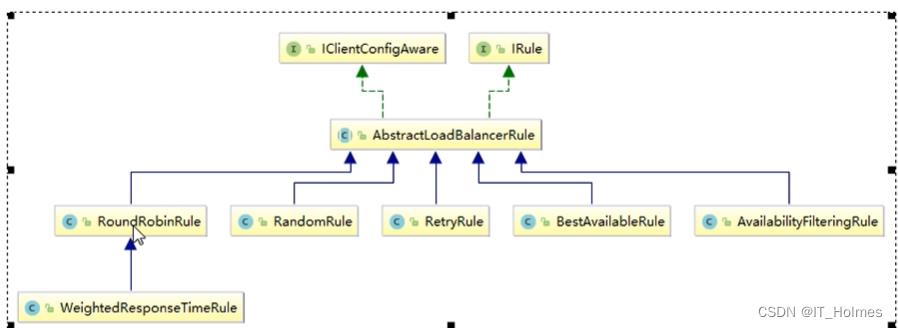
12. Ribbon 之 负载均衡规则替换
配置前,官方文档明确给出警告配置Ribbon的自定义配置类不能放到@ComponentScan所扫描当前包下以及子包下!!

设置自定义配置类:
- 还是要注意这个类不能设置在@ComponentScan所扫描当前包下以及子包下!!
package com.itholmes.myrule;
import com.netflix.loadbalancer.IRule;
import com.netflix.loadbalancer.RandomRule;
import org.springframework.context.annotation.Bean;
import org.springframework.context.annotation.Configuration;
//还是要注意这个类不能设置在@ComponentScan所扫描当前包下以及子包下!!
@Configuration
public class MySelfRule
//注入IRule接口对应的一些实现类
@Bean
public IRule myRule()
//随机规则
return new RandomRule();
SpringBoot启动类:
- 需要添加@RibbonClient注解,指定微服务名称和配置类。
package com.itholmes.springcloud;
import com.itholmes.myrule.MySelfRule;
import org.springframework.boot.SpringApplication;
import org.springframework.boot.autoconfigure.SpringBootApplication;
import org.springframework.cloud.netflix.eureka.EnableEurekaClient;
import org.springframework.cloud.netflix.ribbon.RibbonClient;
@SpringBootApplication
@EnableEurekaClient
//在这指定好,这里的name是要访问那个微服务的名称;configuration来指定负载均衡的规则的配置类。
@RibbonClient(name = "CLOUD-PAYMENT-SERVICE",configuration = MySelfRule.class)
public class OrderMain80
public static void main(String[] args)
SpringApplication.run(OrderMain80.class,args);
13. Ribbon 默认负载均衡轮询算法原理
负载均衡算法:
- rest接口第几次请求数 % 服务器集群总数量 = 实际调用服务器位置下标。
- 每次服务重启动后rest接口计数从1开始。
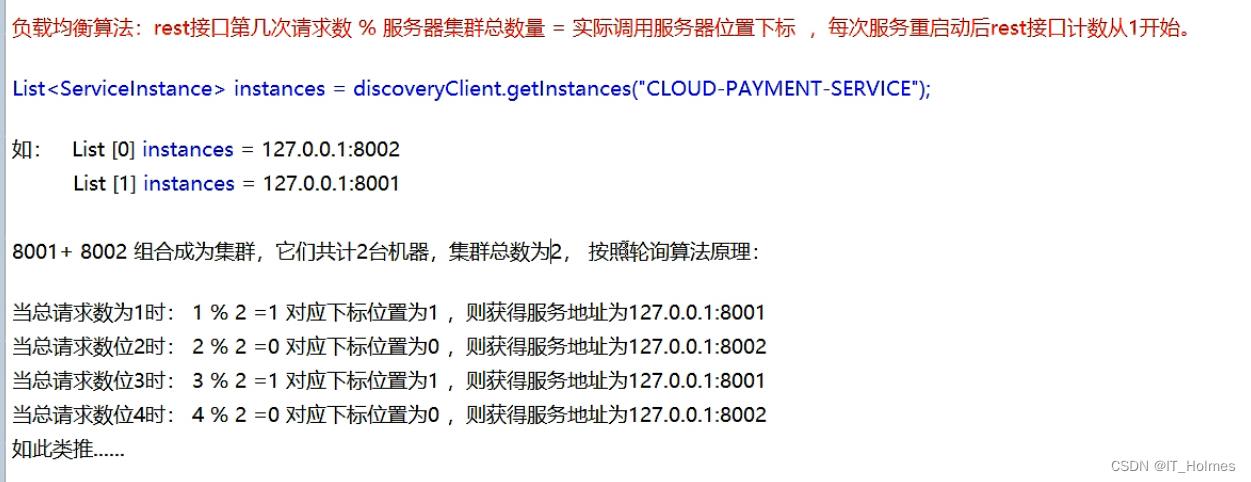
使用到了自旋锁:
什么是自旋锁?
- 自旋锁是指当一个线程尝试获取某个锁时,如果该锁已被其他线程占用,就一直循环检测锁是否被释放,而不是进入线程挂起或睡眠状态。

14. 手写 Ribbon 的轮询算法
定义一个LoadBalancer接口:
package com.itholmes.springcloud.lb;
import org.springframework.cloud.client.ServiceInstance;
import java.util.List;
public interface LoadBalancer
ServiceInstance instances(List<ServiceInstance> serviceInstances);
MyLB类,设置轮询算法:
package com.itholmes.springcloud.lb;
import org.springframework.cloud.client.ServiceInstance;
import org.springframework.stereotype.Component;
import java.util.List;
import java.util.concurrent.atomic.AtomicInteger;
@Component
public class MyLB implements LoadBalancer
/**
* AtomicInteger类是系统底层保护的int类型,通过提供执行方法的控制进行值的原子操作。
* AtomicInteger它不能当作Integer来使用
*
*/
private AtomicInteger atomicInteger = new AtomicInteger(0);
public final int getAndIncrement()
int current;
int next;
do
current = this.atomicInteger.get();
//2147483647是integer的最大值。
next = current >= 2147483647 ? 0 : current + 1;
/**
* java.util.concurrent.atomic.AtomicInteger.compareAndSet()是Java中的一种内置方法,
* 如果当前值等于参数给定的期望值,则将值设置为参数中的传递值。该函数返回一个布尔值,该布尔值使我们了解更新是否完成。
*/
while (!this.atomicInteger.compareAndSet(current,next));
System.out.println("*****第几次访问次数,next:"+next);
以上是关于SpringCloud 学习笔记总结的主要内容,如果未能解决你的问题,请参考以下文章